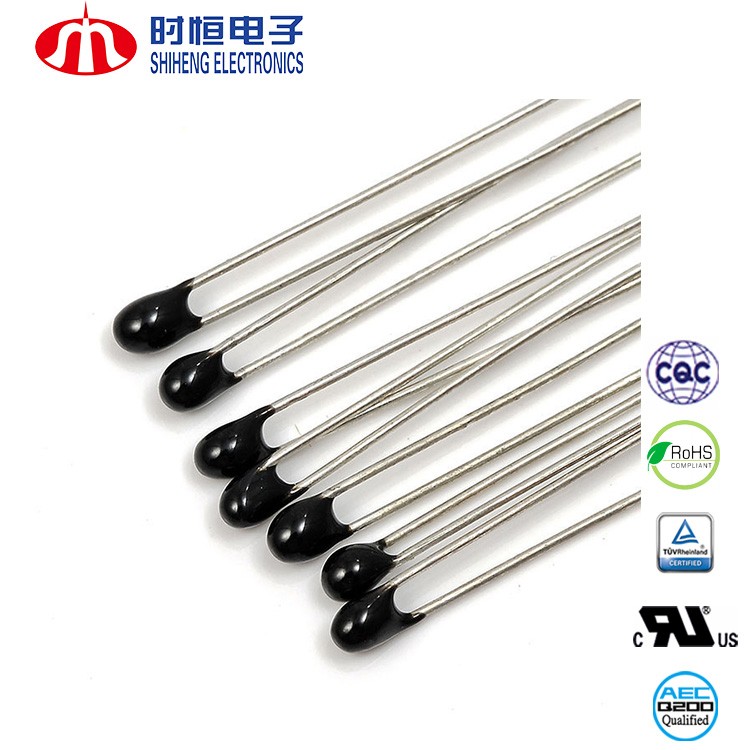ترمیستورهای با پوشش شیشهای در مقابل ترمیستورهای با پوشش اپوکسی: از کدام یک باید استفاده کنید؟
May 16, 2025مقدمه هنگام طراحی محصولی که به حسگر دما متکی است، انتخاب بستهبندی مناسب ترمیستور به همان اندازه انتخاب مشخصات الکتریکی صحیح حیاتی است. دو نوع از رایجترین آنها ترمیستورهای با محفظه شیشهای و ترمیستورهای روکش شده با اپوکسیاما چگونه باید بین آنها یکی را انتخاب کرد؟ پاسخ در درک محیط برنامه و الزامات قابلیت اطمینان نهفته است.
 |  |
در این مقاله، ما بستههای شیشهای و اپوکسی را به صورت رو در رو مقایسه میکنیم تا به شما در انتخاب بهترین گزینه برای طراحیتان کمک کنیم.
۱. تفاوتهای ساخت و مواد:
۲. عملکرد حرارتی و محیطی
ویژگی | روکش اپوکسی | شیشهای محصور شده |
حداکثر دمای عملیاتی | حدود ۱۲۵ درجه سانتیگراد | تا ۲۵۰ درجه سانتیگراد |
مقاومت در برابر رطوبت | متوسط | عالی |
مقاومت شیمیایی | محدود | عالی |
دوام چرخه حرارتی | خوب (استفاده معمولی) | عالی (شرایط سخت) |
ترمیستورهای شیشهای، مانند ما سری MF58، برای کاربردهایی که در معرض چرخههای حرارتی مکرر، رطوبت بالا یا بخارات شیمیایی قرار دارند، ایدهآل هستند.
۳. بدهبستانهای هزینه و کاربرد
اگر طراحی شما نیاز به قابلیت اطمینان طولانی مدت در شرایط سخت دارد، شیشه اغلب ارزش سرمایهگذاری اضافی را دارد.
۴. ملاحظات مکانیکی ترمیستورهای شیشهای سفتتر هستند و ممکن است در هنگام نصب نیاز به مراقبت داشته باشند. در مقابل، نسخههای روکششده با اپوکسی، انعطافپذیری مکانیکی بیشتری دارند و نصب یا قرار دادن آنها در مجموعهها را آسانتر میکنند.
کدام را باید انتخاب کنید؟ از خود بپرسید:
 |  |
اگر به یک سنسور بادوام و با دقت بالا برای محیطهای چالشبرانگیز نیاز دارید، ترمیستورهای با محفظه شیشهای مانند سری MF58 ما انتخاب برتر هستند. برای کاربردهای حساس به هزینه و با کارکرد متوسط، ترمیستورهای با پوشش اپوکسی مانند سری سری MF52 اغلب بیش از حد کافی هستند.
نتیجهگیری انتخاب بسته ترمیستور مناسب به ایجاد تعادل بین عملکرد، هزینه و محیط کاربرد بستگی دارد. در شرکت فناوری الکترونیکی نانجینگ شیهنگ، ما ترمیستورهای اپوکسی و شیشهای را با گزینههای سفارشیسازی سریع و گواهینامههای جهانی ارائه میدهیم.
هنوز مطمئن نیستید کدام را انتخاب کنید؟ تماس با ما برای راهنمایی تخصصی، نمونهها یا راهحلهای سفارشی متناسب با پروژه شما.